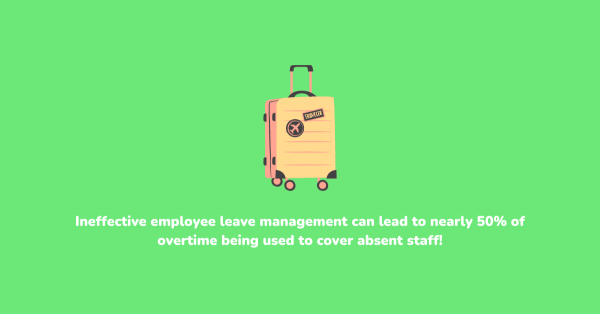Leave management, once a predominantly manual task fraught with errors and inefficiencies, has evolved dramatically with the advent of technology. At the heart of this transformation lies leave management software, a digital solution designed to streamline and optimize the entire process of managing employee absences.
Understanding the Challenges of Manual Leave Management
The traditional approach to managing employee leave, often involving spreadsheets, paper-based systems, or even manual calculations, is a relic of a bygone era. While these methods might have sufficed in smaller organizations with minimal workforce, the complexities and demands of modern businesses in managing employee leave have rendered them woefully inadequate. The repercussions of relying on manual time off are far-reaching, impacting both employees and employers in significant ways.
The Human Factor
One of the most glaring drawbacks of manual time off is the potential for human error. Miscalculations in leave accrual, incorrect deductions, and oversight in recording absences are commonplace. These errors can lead to a domino effect of problems, including:
- Inaccurate Leave Balances - Employees may find themselves confused and frustrated by discrepancies between their perceived leave entitlement and the company's records. This can erode trust and lead to disputes.
- Payroll Errors - Incorrect leave calculations directly impact payroll, resulting in underpayments or overpayments, which can have financial implications for both the employee and the company.
- Compliance Issues - Errors in leave tracking can lead to non-compliance with labor laws, exposing the organization to legal risks and penalties.
Beyond the risk of errors, manual time off is an incredibly time-consuming process. HR teams often find themselves bogged down in administrative tasks, such as:
- Manual Data Entry - Inputting leave requests, updates, and changes into spreadsheets or paper forms is time-consuming and prone to errors.
- Complex Calculations - Calculating leave accruals, deductions, and balances manually is laborious and susceptible to mistakes.
- Generating Reports - Producing leave reports for management or other departments requires significant effort and time.
These time-consuming tasks divert HR's attention from strategic initiatives and employee relations, impacting overall organizational efficiency.
Lack of Visibility and Control
Manual leave management systems offer limited visibility into leave patterns and trends. Without a centralized platform to aggregate data, it is challenging to:
- Identify Staffing Shortages - Predicting and addressing potential staffing gaps is difficult when leave information is scattered across various documents.
- Analyze Leave Patterns - Understanding leave trends can help identify potential issues, such as excessive sick leave or burnout.
- Enforce Leave Policies - Monitoring adherence to leave policies is challenging without a system to track leave usage and approvals.
Furthermore, manual systems provide limited control over the leave approval process. Managers often rely on email or paper-based requests, which can lead to delays, confusion, and inconsistencies.
The Impact on Employees and the Bottom Line
The challenges associated with manual time off extend beyond HR and impact employees directly. Inaccurate leave balances, delayed approvals, and complex processes can lead to frustration, decreased job satisfaction, and even increased absenteeism. Moreover, the time wasted by employees in managing their leave can negatively impact productivity.
From a financial perspective, the costs of manual paid time off management are substantial. Errors, inefficiencies, and compliance risks can result in significant financial losses. Additionally, the negative impact on employee morale and productivity can affect the bottom line.
The Solution
Leave management software emerges as a powerful tool to address these challenges. It is a comprehensive system that automates and simplifies various aspects of the paid time off process, from leave requests to accrual calculations and reporting. By centralizing leave data and providing real-time insights, this software empowers HR teams to make informed decisions and enhance overall operational efficiency.
Essentially, the best leave management software serves as a digital hub for managing employee absences, ensuring accuracy, transparency, and compliance. It offers a range of functionalities to cater to the diverse needs of businesses, from small startups to large enterprises.
By implementing leave management software, organizations can expect to experience significant improvements in efficiency, employee satisfaction, and overall HR operations.
Understanding Leave Management Software
PTO tracking software is a versatile tool designed to streamline and optimize the entire paid time off process within an organization. It encompasses a broad range of functionalities that cater to the diverse needs of businesses, from small-scale operations to large enterprises.
Core Functionalities of Leave Management Software
At the heart of any PTO tracking software lies a robust set of core functionalities. These features are essential for effective absence management and include:
- Leave Request and Approval Process - The software facilitates the submission, review, and approval of leave requests, ensuring a streamlined workflow. Employees can easily submit leave applications, while managers can efficiently review and approve or deny requests.
- Accrual and Balance Tracking - Accurately tracking leave accruals and balances is crucial. PTO tracking software automatically calculates leave accruals based on predefined rules and maintains up-to-date records of employee leave entitlements.
- Leave Policy Management - The software allows organizations to define and manage various leave types, such as paid time off (PTO), sick leave, vacation, and parental leave. It ensures compliance with company policies and legal requirements.
- Time-Off Calendars and Scheduling - Visualizing leave schedules is essential for effective workforce planning. PTO tracking software provides time-off calendars that display employee availability, helping managers allocate resources efficiently.
- Integrations with HRIS and Payroll Systems - Seamless integration with existing HR information systems (HRIS) and payroll systems is vital for data consistency and automation. PTO tracking software can synchronize employee data, leave balances, and payroll deductions.
By incorporating these core functionalities, these software provides a solid foundation for managing employee absences effectively.
Benefits of Using PTO Software

Implementing PTO software offers numerous advantages for both employees and employers. These benefits include:
- Improved Efficiency and Accuracy - Automation of leave-related tasks reduces manual effort, minimizes errors, and saves time for HR teams.
- Enhanced Employee Satisfaction - Self-service portals empower employees to manage their leave requests independently, improving their overall experience.
- Better Compliance with Labor Laws - Staying up-to-date with complex labor regulations can be challenging. PTO software helps ensure compliance by automating calculations and tracking leave entitlements accurately.
- Data-Driven Insights for HR - Comprehensive data on leave patterns and trends enables HR teams to make informed decisions regarding staffing, workload distribution, and policy adjustments.
By leveraging the benefits of PTO software, organizations can create a more efficient, compliant, and employee-friendly work environment.
Key Features of PTO Software
Paid time off tracking software offers a robust suite of features designed to streamline and optimize the absence management process. These features can be categorized into essential and advanced functionalities.
Essential Features
- Self-Service Portal - A user-friendly, intuitive portal empowers employees to independently manage their leave requests, check balances, view leave history, and access relevant leave policies. This self-service capability significantly reduces the administrative burden on HR teams, allowing them to focus on strategic initiatives.
- Mobile Accessibility - In today's mobile-centric world, providing access to absence management through mobile devices is crucial. A mobile app or responsive website enables employees to submit leave requests, check balances, and view leave policies on the go, enhancing flexibility and convenience.
- Customizable Leave Types - Effective absence management requires the ability to define and configure various leave types to align with an organization's specific policies and industry regulations. Paid time off tracking software should offer flexibility in creating custom leave categories, such as paid time off (PTO), sick leave, vacation, maternity/paternity leave, personal leave, bereavement leave, and more.
- Accrual Rules and Calculations - Accurate and timely calculation of leave accruals is essential for compliance and employee satisfaction. The software should support complex accrual rules, including tiered accrual rates, carryover policies, and blackout periods. It should also provide clear visibility into leave balances and accrual progress.
- Approval Workflows - Streamlined approval processes are vital for efficient absence management. The software should allow organizations to define customized approval workflows based on employee roles, department structures, and leave types. This ensures that leave requests are routed to the appropriate approvers for timely decision-making.
- Calendar and Scheduling - Visualizing leave schedules is crucial for workforce planning and resource allocation. Paid time off tracking software should provide intuitive calendar views to display employee availability, overlapping leave periods, and potential staffing shortages.
- Integrations - Seamless integration with existing HR systems, payroll systems, and other HR modules is essential for data consistency and efficiency. The software should be able to synchronize employee data, leave balances, and payroll deductions, reducing manual data entry and minimizing errors. Additionally, integration with time and attendance systems can provide comprehensive workforce management capabilities.
Advanced Features
While essential features form the foundation of paid time off tracking software, advanced functionalities enhance its value proposition and provide organizations with deeper insights and capabilities:
- Time-Off Forecasting - By analyzing historical leave data and patterns, the software can predict future leave trends, helping organizations anticipate staffing needs, optimize resource allocation, and avoid potential disruptions.
- Absence Analytics - Comprehensive reporting and analytics capabilities enable HR teams to gain valuable insights into leave patterns, absence rates, and cost implications. This data-driven approach supports informed decision-making, identifies potential issues, and helps measure the impact of absence management strategies.
- Compliance Tracking - Staying compliant with complex labor laws and regulations is crucial. Paid time off tracking software should offer features to help organizations track leave entitlements, calculate statutory leave benefits, and generate compliance reports.
- Integrations with Other HR Modules - Comprehensive integration with other HR modules, such as performance management, talent acquisition, and benefits administration, creates a unified HR platform. This integration streamlines HR processes, improves data accuracy, and provides a holistic view of the workforce.
- Mobile Approvals - Empowering managers to approve leave requests on the go through mobile devices enhances efficiency and responsiveness.
- Employee Self-Service - Expanding employee self-service capabilities beyond basic leave requests to include leave policy access, balance inquiries, and leave history can improve employee satisfaction and reduce HR workload.
- Absence Management - For organizations with high absence rates, advanced absence management features, such as absence case management, short-term disability tracking, and return-to-work programs, can help manage complex absence situations and reduce costs.
By incorporating a combination of essential and advanced features, a leave management solution can significantly enhance an organization's ability to manage employee absences effectively, improve operational efficiency, and optimize workforce planning.
Selecting the Right Software

Choosing the ideal paid time off tracker is a pivotal decision for organizations of all sizes. A well-matched solution can significantly enhance operational efficiency, improve employee satisfaction, and ensure compliance with labor regulations.
Factors to Consider When Choosing the Best Software
The selection process for leave management solution necessitates a comprehensive evaluation of various factors to ensure the chosen solution aligns with the organization’s unique requirements.
- Business Size and Industry - The scale of an organization and its specific industry sector play a crucial role in determining the appropriate software features. Small businesses might prioritize simplicity and affordability, while larger enterprises may require advanced functionalities such as time-off forecasting and absence analytics. Industries with stringent compliance regulations, such as healthcare or government, have specific software needs that must be met.
- Number of Employees - The number of employees directly impacts the software's capacity and scalability. A solution designed for a small team might not be suitable for a large organization with complex leave policies and multiple locations.
- Required Features - Identifying essential and desired features is paramount. Core functionalities such as leave request management, accrual tracking, and approval workflows are fundamental. Advanced features like time-off forecasting, absence analytics, and integration capabilities may be necessary for organizations seeking to optimize their processes in managing employee leave.
- Budget - Establishing a clear budget is essential to narrow down software options. Consider the initial investment, ongoing costs, implementation expenses, and potential return on investment (ROI).
- Ease of Use - A user-friendly interface is crucial for both HR administrators and employees. The software should be intuitive, with minimal training required to ensure adoption and productivity.
- Customer Support - Reliable and responsive customer support is essential for addressing issues, providing guidance, and ensuring a smooth implementation process. Evaluate the availability of support channels (phone, email, live chat), response times, and the overall quality of support services.
- Data Security and Privacy - Given the sensitive nature of employee data, robust data security measures are paramount. Ensure the software complies with relevant data protection regulations (such as GDPR or CCPA) and has measures in place to safeguard employee information.
- Scalability - Consider the organization's growth plans. The chosen software should be able to accommodate an increasing number of employees and evolving leave requirements.
- Implementation and Integration - Evaluate the software's implementation process, including the time required, resources needed, and the level of customization involved. Additionally, assess the software's ability to integrate with existing HR systems, payroll systems, and other relevant applications.
Comparison of Different Types of PTO Software
Understanding the various types of leave management solutions available is essential for making an informed decision.
- Cloud-Based Software
- Offers flexibility and accessibility as it can be accessed from any internet-connected device.
- Typically requires a subscription-based payment model.
- Data is stored and managed by the software provider, potentially raising concerns about data security for some organizations.
- Often includes automatic updates and feature enhancements.
- On-Premises Software
- Provides greater control over data security as the software is installed on the organization's servers.
- Requires upfront investment in hardware, software, and IT support.
- May involve higher maintenance costs and IT resource allocation.
- Offers customization options but may require more extensive implementation efforts.
- Standalone Software
- Focuses solely on functionalities relating to managing employee leave.
- May lack integration capabilities with other HR systems, limiting its overall functionality.
- Often suitable for small organizations with basic requirements in managing employee leave.
- Integrated Software
- Typically part of a larger HR suite, providing seamless integration with other HR modules such as payroll, time and attendance, and performance management.
- Offers a comprehensive view of employee data and HR processes.
- May have a higher initial cost but can lead to increased efficiency and cost savings in the long run.
By carefully considering these factors and comparing different software options, organizations can select the leave management solution that best aligns with their specific needs, budget, and long-term goals.
Why OrangeHRM?
OrangeHRM's PTO/Leave Management module is designed to revolutionize the way you handle employee absences. By automating time-consuming tasks and providing a centralized platform for managing leave requests, approvals, and tracking, OrangeHRM simplifies the entire leave process. With intuitive dashboards and real-time analytics, you can gain valuable insights into leave patterns, employee attendance, and staffing needs. Experience enhanced efficiency, improved employee satisfaction, and reduced administrative burdens with OrangeHRM's comprehensive solution. See OrangeHRM in action by booking your FREE demo today!
